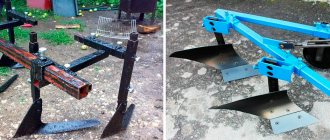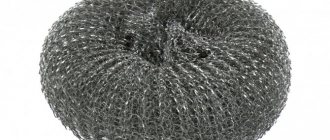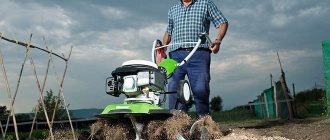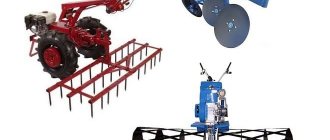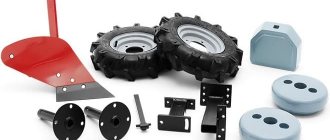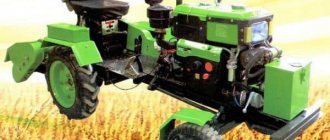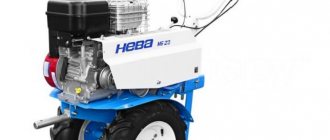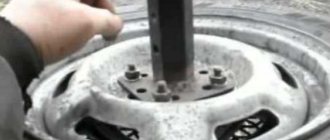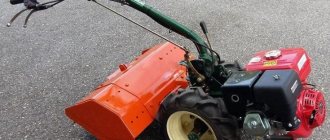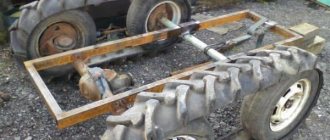As soon as walk-behind tractors and walk-behind cultivators appeared on the market, manufacturers began to think about additional mechanisms for them, such as trenchers for walk-behind tractors, hillers, mowers, and potato diggers. All this helps amateur gardeners and farmers carry out any work on their land plots such as cultivating the soil, planting vegetables, harvesting, and mowing grass. Mounted and trailed machines facilitate manual labor, increase productivity, speed up and simplify the process as a result of mechanization.
This review will consider one of the types of attachments - a trencher for a walk-behind tractor.
Basic information
In industrial construction, excavators have always been used to lay ditches for pipelines, electrical network cables, and communications.
A walk-behind trencher is a compact and maneuverable mounted mini-excavator. Land owners use it for the following purposes:
- digging holes, ditches;
- removal of the top layer of road surface that has become unusable;
- cutting out soil layers;
- loosening the soil;
- preparing the site for planting;
- arrangement of the foundation;
- land reclamation;
- drainage.
There are 2 types of trenchers:
- Whole. This mechanism is integral with the walk-behind tractor. Most often it is used by landscape designers and professional builders. The most popular models are Barreto 912HM, Laski TR50/CH270/50, Sable /BS/50 and Ground Hog T4.
- Mounted. Produced by the manufacturer specifically for a specific type of walk-behind tractor. In the CIS markets, a mounted trencher is presented by Quick Attach and is called Trench It. The soil cutter has dimensions of 1.025x0.61x2.01 m, weight - 272 kg, lays trenches 0.96 m deep. It is used for aggregation with walk-behind tractors from world manufacturers Yanmar, Bobcat, Case, Daewoo, John Deere using special couplings.
Solid equipment is very expensive, so it is in demand only among professionals.
The main criteria for evaluating trenchers are:
- digging depth;
- trench length;
- speed of work.
Mounted units have the following advantages:
- minimum soil after excavation in the digging area;
- the possibility of using soil for other purposes;
- compactness;
- high reliability of components and connections;
- low fuel consumption;
- no damage to the soil surface;
- accuracy of work;
- smooth edges of the trench (the earth does not fall back into the hole);
- high performance when working with frozen soil;
- simple operation and maintenance;
- affordable price;
- lack of permitting documents.
It is difficult for a user to choose the best model among a wide variety of diggers. All of them are designed to work in different conditions and achieve specific goals. Digging depth and productivity depend on the weight and power of the unit. The price directly depends on these factors.
Description
A trencher for a walk-behind tractor is an equipment that can make the life of its owner many times easier if he plans to lay communications, carry out gardening and other work where digging long and narrow trenches is indispensable.
Of course, there are special motorized units - industrial-level trenchers, the digging depth of which can reach 1 meter 20 centimeters. Smooth, strong cuts of the cut hold their shape perfectly and do not crumble. This is excellent equipment; its only drawback is its high cost, available only to specialized organizations.
What should owners of private houses and land do when a shovel is not able to help, but they have a walk-behind tractor on the farm? And then a real way to solve the problem appears - an attachment on a walk-behind tractor for digging trenches. Digging trenches with a walk-behind tractor will take much less time and effort, which will also have a beneficial effect on labor productivity.
The best models of walk-behind tractors with a trencher
A manual small-sized soil cutter is sometimes called a walk-behind tractor (cultivator) with a trencher. If you decide to buy this unit for digging straight ditches for laying electrical cables or plumbing pipes in a gardening area, choosing the right unit is not so easy.
Among the wide variety of models of small-sized trench-digging equipment offered on the market, we will consider the most popular ones.
- LASKI TR 50/CH270/60 – Czech non-self-propelled trencher. High productivity of the unit is achieved due to the operating speed of 60 m/h. The machine is equipped with a single-cylinder four-stroke engine KOHLER Command Pro CH270 with a power of 5.2 hp. The digging width is 10 cm, the depth is 60 cm. The weight of the machine is small - 135 kg, so it is very easy to operate. You can purchase this model of specialized equipment in Russia for an average of 260 thousand rubles.
- ASTEC RT130 is a small-sized model of an American brand trencher. It shows good results when working with hard and rocky soil. The unit is equipped with a Japanese gasoline Honda engine with a power of 9.70 kW. The maximum trench depth is 1067 mm, and the width is 150 mm. The speed at which the soil cutter digs is 2.4 km/h, its operating weight is 327 kg. In the Russian Federation and CIS countries, this model is not available for free sale; it is supplied only upon order.
- Ground Hog T4 is a mini-trencher designed for developing ditches for laying utility lines. The weight of the machine is only 80 kg, which makes it mobile and easy to transport. The engine installed on the unit is Subaru EX with a power of 4.1 kW. Digging width is 12 cm, depth is 30 cm. The average cost in dealer stores is 135,000 rubles.
- SABLE T/GX200/70 HARD is a Russian-made soil cutter that allows you to dig up hard soil interspersed with small stones up to 5 cm in size. It is the equipment for heavy soil that is the main advantage for many buyers. The trencher has the following technical characteristics: maximum trench depth – 65 cm, optionally selected width – from 7 to 17 cm, machine motor power – 6.5 hp, weight – 125 kg. The average price in the Russian Federation is 280 thousand rubles.
Advantages and disadvantages
If it is not possible to completely mechanize trench digging, then this can be done at least partially.
A walk-behind tractor or a walk-behind drill makes the task of digging a trench easier, speeding it up - this is the main advantage of using this technique. A few more advantages:
- A moderate amount of work can be accomplished.
- You can make a narrow and deep trench.
- Acceleration of time.
- The cost is lower than manual labor.
The disadvantage of this method is that you still have to use manual labor. Compared to a bulldozer, which digs up soil and piles it next to the trench, a second person will have to walk behind the operator working with a walk-behind tractor and collect the soil with a shovel.
You will find all the most important things about manual trenching in this section.
Mounted trenchers for walk-behind tractors
Attachments for digging trenches have impressive dimensions and heavy weight, so they are mounted only on heavy walk-behind tractors or mini-tractors running on gasoline or diesel fuel, with an engine power of 8 to 15 hp. A universal walk-behind tractor (or trencher) is represented on the market by the Quick Attach Trench It trencher. This attachment is capable of digging trenches for laying cables and pipes with a depth of 96 cm, and will also be useful for such work as: removing road surfaces, planting trees, cutting out soil blocks. When purchasing a ditch digger, you can select the cutting elements of the chain based on the properties of the soil being processed, and the depth of the trench being dug is regulated by rearranging the skid. There is no equipment available for free sale on the territory of the Russian Federation, so the price is clarified upon request to the manufacturer directly.
For owners of HUSQVARNA walk-behind tractors, the company produces an active hiller-trencher, the working width of which is 30 cm. It is suitable for digging ditches in soft and medium-density soil for planting trees, a drainage system or an irrigation system for a personal plot. It is driven by the power take-off shaft of the walk-behind tractor. At official dealers in Russia, prices vary from 55 to 80 thousand rubles. The device can also be found much cheaper on the secondary market.
The lineup
It is worth distinguishing two categories of technology:
Specialized equipment is represented by brands:
- Laski TR50;
- OJSC "Mikhnevsky RMZ";
- Kwik-TrenchEarthSaw;
- GroundHog T4;
- TKMG-1200;
- Sable /BS/50/;
- Vermeer RT60;
- Barreto 912HM;
- GroundHog T-4 Trencher.
Motoblock trenchers are represented by the TrenckIt model, which is produced by the manufacturer QuickAttah. This equipment is connected to both gasoline and diesel walk-behind tractors, the engine power of which ranges from 8 to 15 horsepower. For ease of work, tracked or wheel-driven equipment can be used.
DIY trencher for walk-behind tractor
For construction work on a personal plot, development of territory near the house, when laying sewer, water pipes and cable networks, summer residents and small landowners need a ditch digger. Solid and mounted units, which are offered on domestic markets, are not cheap and are suitable only for certain walk-behind tractors. Therefore, many owners decide to make a trencher for a walk-behind tractor with their own hands.
A homemade unit must meet the following requirements:
- aggregation with a walk-behind tractor with a power of 8-13 hp. with PTO;
- power plant: hydraulic pump NSh-10, cutter motor GMSh-32;
- cutting system: 2 road milling machines ETs-1800;
- the depth of the ditch is up to 0.35 m, and the width is 0.10-0.15 m;
- Approximate weight: 80 kg.
In order to make a ditch digger yourself, you need the following materials and equipment:
- welding machine;
- Bulgarian;
- road milling machines;
- dump shovel;
- protective covers.
The main working unit of the machine is the hinged body, consisting of the following elements:
- soil cutting disc;
- chain transmission;
- hydraulic motor;
- linkage shaft;
- disc bar.
The process of making a ditch digger is not difficult for the master and consists of the following:
- A bar with soil-cutting cutters is installed on the front suspension.
- A moldboard shovel for removing soil from a trench is mounted on the rear suspension.
- The cutting system and chain drive are equipped with a protective cover.
When you turn on the engine from the walk-behind tractor, the hydraulic system of the mounted mechanism starts. The transmission of torque to the chassis must be switched off. The hydraulic system of the cutter is started, the disks begin to rotate, and a trench is cut. The chassis drive encourages the walk-behind tractor to move. At this time, the dump shovel selects the destroyed soil with cutters and throws it onto the upper part of the trench. The operator uses virtually no special effort.
A homemade trencher will save money, facilitate manual labor and become an excellent assistant when carrying out many works on personal plots.
Owner reviews
Ivan, 36 years old:
I want to say a few words in favor of the trencher. Three years ago I bought a dacha, decided to build it, left the old house as a barn, and started building a new home for my family. The construction would have dragged on for a long time if not for the advice of good people. Basically, all digging work was carried out by machines (I hired the appropriate equipment), including trenches for the foundation (a tractor with a soil cutter arrived and did everything in a couple of hours). Later, when the box was ready and it was time to pull the communications, I remembered about the soil cutter and found compact analogues for walk-behind tractors on the Internet. I decided not to waste my money, but to make a tool with my own hands. The trencher was worth the effort, and I subsequently began using it in the garden. Now the construction is finished and my family lives in a cozy cottage, a garden, a small vegetable garden - everything is like people’s.
Sergey, 54 years old:
I also had construction going on at my site, so I really needed a trencher. I couldn’t find one that would fit my Oka, so I decided to make the mount myself. The experiment was a success, but the depth of cutting the soil was too small - 25 cm. I ran electricity throughout the entire area, then I decided to use the soil cutter in an aesthetic direction - I cut trenches for borders, built a small grotto in the garden - also not without the participation of the soil cutter.
Alexey, 31 years old:
Hello! My father has a Neva walk-behind tractor, I want to use it to the maximum, there is construction ahead, I would like to make the work easier by adapting the walk-behind tractor. Please advise which manufacturer to choose, which specific model? I even agree to make a homemade product, I can do it myself, but there are no specifics on the Internet, I would like step-by-step instructions for making a soil cutter. Thank you in advance!
Trenchers are one of the types of excavator mechanisms used for arranging trenches when laying underground pipelines for placing pipes for various purposes, cable electrical networks, and communications communications.
Can be used by land owners and utility services in land reclamation, drainage, and foundation construction work.
DIY trencher chain
For a homemade mini-ditch digger, you can make a chain yourself from scratch, but this is a very difficult task. Therefore, to simplify the work, you can buy a chain from a used soil cutter or any other agricultural machinery, shorten it to the desired size, and weld on the teeth made by yourself. They are cut from a sheet of high-strength steel and reinforced with pobedite brazing.
A chain made in this way can be installed on homemade trenchers for heavy walk-behind tractors Neva, MTZ, Kaskad, Agro and others, with a power of at least 8 hp.
How to make a trencher from a chainsaw
To make a mobile manual soil cutter from a powerful professional or semi-professional chainsaw, it is enough to purchase a special trencher attachment at a gardening or construction equipment store, which is a chain with large, powerful teeth located at a fairly large distance from each other.
The second option is to modify the original chainsaw chain. Based on the drawings of chainsaw trenchers (they are produced by Husqvarna, Shtihl, Makita and others), make steel teeth and weld them to the links at equal intervals.


